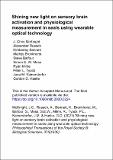Files in this item
Shining new light on sensory brain activation and physiological measurement in seals using wearable optical technology
Item metadata
| dc.contributor.author | McKnight, Chris | |
| dc.contributor.author | Ruesch, Alexander | |
| dc.contributor.author | Bennett, Kimberley | |
| dc.contributor.author | Bronkhorst, Mathijs | |
| dc.contributor.author | Balfour, Steven Thomas | |
| dc.contributor.author | Moss, Simon | |
| dc.contributor.author | Milne, Ryan | |
| dc.contributor.author | Tyack, Peter Lloyd | |
| dc.contributor.author | Kainerstorfer, Jana | |
| dc.contributor.author | Hastie, Gordon Drummond | |
| dc.date.accessioned | 2021-12-16T16:30:01Z | |
| dc.date.available | 2021-12-16T16:30:01Z | |
| dc.date.issued | 2021-08-02 | |
| dc.identifier | 271534633 | |
| dc.identifier | 2167f50b-4e2f-4b40-916d-b3d1127a3788 | |
| dc.identifier | 85104012740 | |
| dc.identifier | 000663556900002 | |
| dc.identifier.citation | McKnight , C , Ruesch , A , Bennett , K , Bronkhorst , M , Balfour , S T , Moss , S , Milne , R , Tyack , P L , Kainerstorfer , J & Hastie , G D 2021 , ' Shining new light on sensory brain activation and physiological measurement in seals using wearable optical technology ' , Philosophical Transactions of the Royal Society B: Biological Sciences , vol. 376 , no. 1830 , 20200224 . https://doi.org/10.1098/rstb.2020.0224 | en |
| dc.identifier.issn | 0962-8436 | |
| dc.identifier.other | ORCID: /0000-0002-9773-2755/work/95418473 | |
| dc.identifier.other | ORCID: /0000-0002-8409-4790/work/95418488 | |
| dc.identifier.other | ORCID: /0000-0002-3872-4886/work/95418575 | |
| dc.identifier.uri | https://hdl.handle.net/10023/24530 | |
| dc.description | This project was funded as part of the Department for Business, Energy and Industrial Strategy Offshore Energy Strategic Environmental Assessment Programme. Supplementary funding supporting J.C.M. and P.L.T. was provided by the US Office of Naval Research (ONR) grant nos N00014-18-1-2062 and N00014-20-1-2709. Supplementary funding supporting J.K. and A.R. was provided by the US Office of Naval Research (ONR) grant no. N00014-19-1-1223. Assistance in funding for acquisition of the fNIRS system was provided by SMRU Consulting's 10th Anniversary Award. | en |
| dc.description.abstract | Sensory ecology and physiology of free-ranging animals is challenging to study but underpins our understanding of decision making in the wild. Existing non-invasive human biomedical technology offers tools that could be harnessed to address these challenges. Functional near-infrared spectroscopy (fNIRS), a wearable, non-invasive biomedical imaging technique measures oxy- and deoxyhemoglobin concentration changes that can be used to detect localised neural activation in the brain. We tested the efficacy of fNIRS to detect cortical activation in grey seals (Halichoerus grypus) and identify regions of the cortex associated with different senses (vision, hearing and touch). Activation of specific cerebral areas in seals was detected by fNIRS in responses to light (vision), sound (hearing) and whisker stimulation (touch). Physiological parameters, including heart and breathing rate, were also extracted from the fNIRS signal, which allowed neural and physiological responses to be monitored simultaneously. This is the first time fNIRS has been used to detect cortical activation in a non-domesticated or laboratory animal. Since fNIRS is non-invasive and wearable, this study demonstrates its potential as a tool to quantitatively investigate sensory perception and brain function while simultaneously recording physiological dynamics that allow calculation of heart rate, tissue and arterial oxygen saturation of haemoglobin, respectively, perfusion changes and breathing rate in free-ranging animals. | |
| dc.format.extent | 13 | |
| dc.format.extent | 1938802 | |
| dc.language.iso | eng | |
| dc.relation.ispartof | Philosophical Transactions of the Royal Society B: Biological Sciences | en |
| dc.subject | Functional near-infrared spectroscopy | en |
| dc.subject | Near-infrared spectroscopy | en |
| dc.subject | Seal | en |
| dc.subject | Sensory ecology | en |
| dc.subject | Brain activation | en |
| dc.subject | QL Zoology | en |
| dc.subject | TD Environmental technology. Sanitary engineering | en |
| dc.subject | DAS | en |
| dc.subject | BEIS/DECC | en |
| dc.subject | NERC | en |
| dc.subject.lcc | QL | en |
| dc.subject.lcc | TD | en |
| dc.title | Shining new light on sensory brain activation and physiological measurement in seals using wearable optical technology | en |
| dc.type | Journal article | en |
| dc.contributor.sponsor | NERC | en |
| dc.contributor.sponsor | NERC | en |
| dc.contributor.institution | University of St Andrews. School of Biology | en |
| dc.contributor.institution | University of St Andrews. Sea Mammal Research Unit | en |
| dc.identifier.doi | https://doi.org/10.1098/rstb.2020.0224 | |
| dc.description.status | Peer reviewed | en |
| dc.identifier.url | https://rke.abertay.ac.uk/en/publications/shining-new-light-on-sensory-brain-activation-and-physiological-m | en |
| dc.identifier.grantnumber | NE/R015007/1 | en |
| dc.identifier.grantnumber | Agreement R8-H12-86 | en |
This item appears in the following Collection(s)
Items in the St Andrews Research Repository are protected by copyright, with all rights reserved, unless otherwise indicated.

